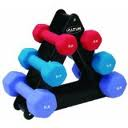Walking with Weights (Good or Bad?)
 |
My plan this week was to write an article on the benefits of walking with
dumbbells (weights) having recently acquired some with the believe that it would
help strengthen my upper arm muscles and aid in burning more calories. So I got
onto the internet and started researching the topic and lo and behold the
experts are divided in their views. One school of thought says it is good while
the other says it can cause your more harm than good.
|
Below are the arguments put forward for and against
the use of weights
FOR
Using dumbbells while walking offers more health benefits in comparison to
walking without them, but this benefit comes with risk.
The maximum recommended weight for dumbbells while walking is 3 lbs. in each
hand. Increasing the weight places more stress on the muscles and joints in your
upper body. This added stress can lead to injuries.
Two-thirds of the oxygen uptake and calorie-burning benefits of holding
dumbbells while walking is attributed to the user swinging his arms more than
when walking without them. By simply engaging your upper body while walking, the
health benefits increase.
Holding dumbbells while walking increases the amount of calories you burn by 5
to 15 percent in comparison to walking without them according to information
from the American College of Sports Medicine.
Some people hold dumbbells while walking on the treadmill. However, you have
other options to intensify your workout when you use cardio machines that do not
place your joints and muscles at risk for injury. To increase the amount of
calories you burn while walking on the treadmill increase your speed, resistance
level or incline instead of carrying dumbbells.
Some fitness enthusiasts use ankle weights to intensify their workout while
walking. However, carrying weight in your hands is more beneficial. Holding
dumbbells increases your heart rate five to 10 beats per minute, while ankle
weights increases your heart rate three to five beats per minute. Holding
dumbbells increases your oxygen uptake by 5 to 15 percent, while ankle weights
increase your oxygen uptake by 5 to 10 percent. Additionally, wearing ankle
weights alters your gait which has the potential to cause injury and
musculoskeletal pain.
Wearing a weight vest for walking and other activities is becoming popular with
fitness enthusiasts. Dumbbells and weight vests produce comparable results when
it comes to burning calories. Walking with a weight vest that is about 20
percent of your body weight increases the amount of calories you burn during
your workout by 14 percent, compared to holding dumbbells which burns 5 to 15
percent.
Source:
http://www.livestrong.com/article/424948-dumbbells-while-walking
AGAINST
Many people incorporate hand weights into their walking workout under the
assumption that it will burn more calories and tone their arms at the same time.
The idea is that carrying weights while you swing your arms will create enough
resistance to tone the muscles in your arms while your legs are toned through
walking.
According to PBS's walking expert Mark Fenton, hand weights will cause your arms
to tire out, which in turn will cause your legs to slow down. This could shorten
your workout, which will, of course, cause you to burn fewer calories. Hand
weights throw off your alignment, which can cause problems all over your body,
and could eventually require a chiropractor to realign.
Unfortunately, the swinging action -- and some walkers may swing their arms
quite forcefully while carrying weights -- can damage joints and arm muscles,
according to MissouriFamilies.org. If you have never had joint problems in the
past, walking with weights may cause such problems to develop. In addition,
MissouriFamilies.org reports that it can actually raise your blood pressure.
Source:
http://www.livestrong.com/article/453259-the-use-of-hand-weights-while-walking/
REALITY CHECK
What do you think?